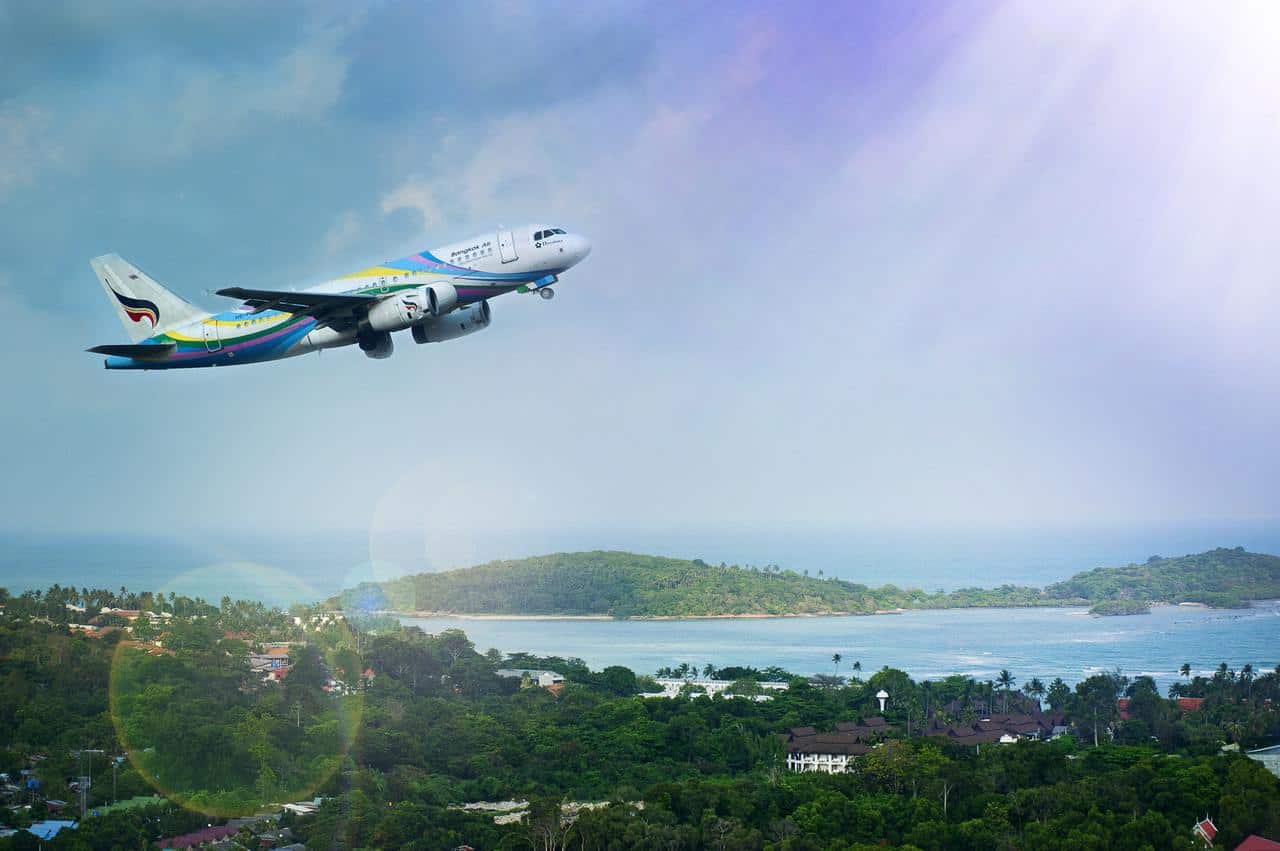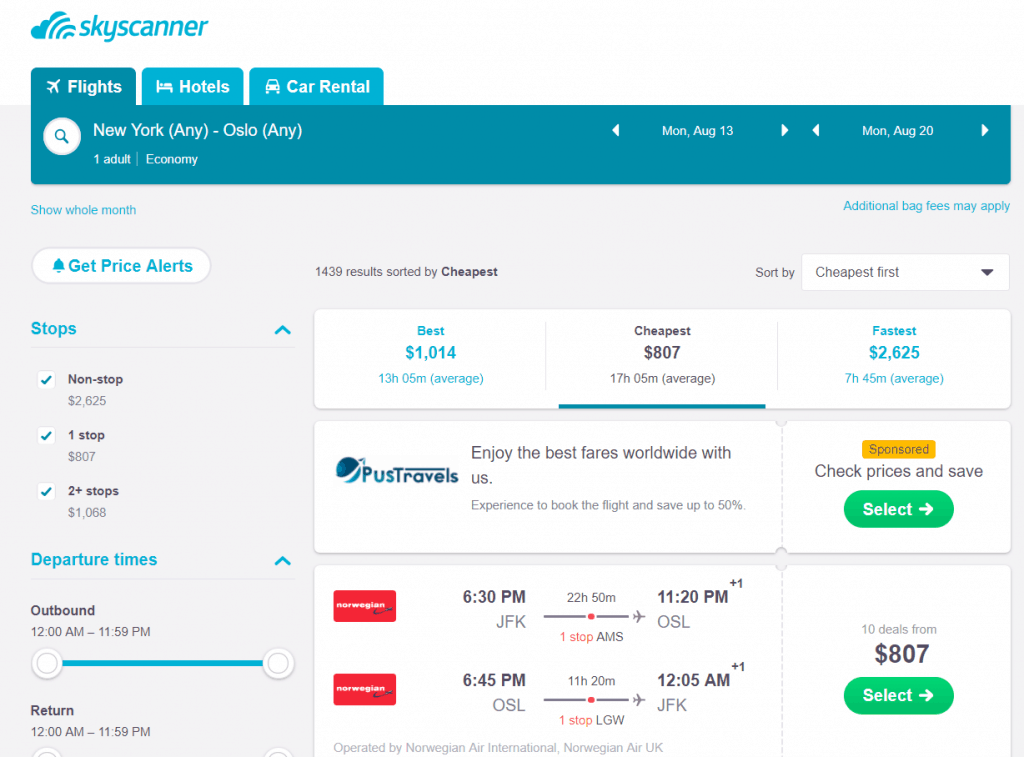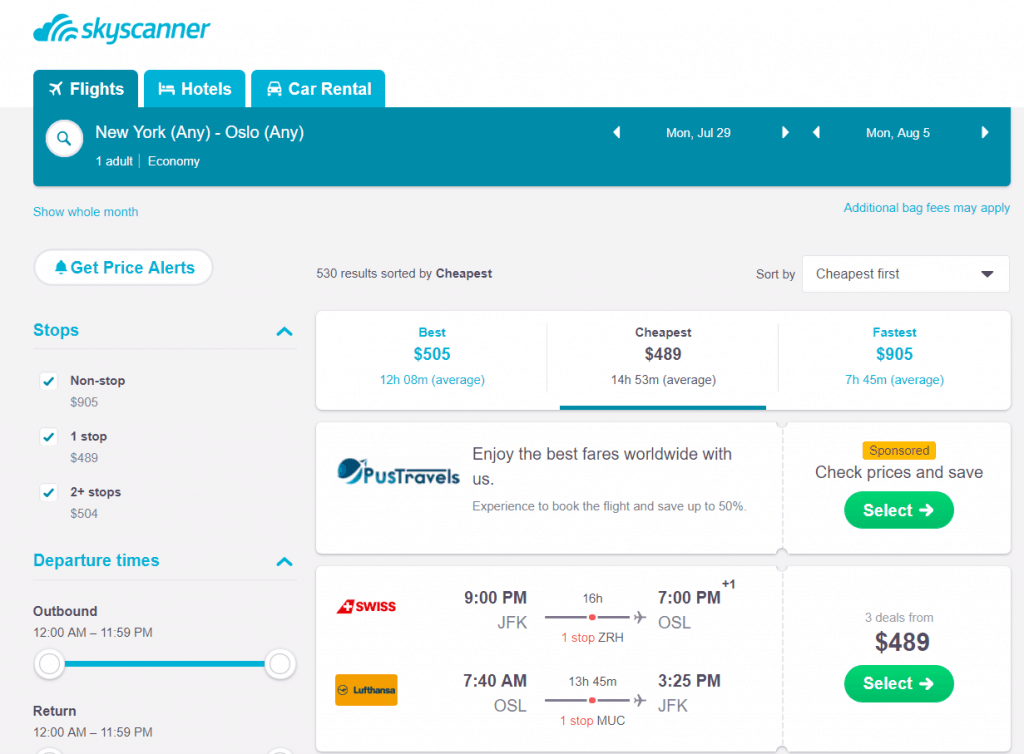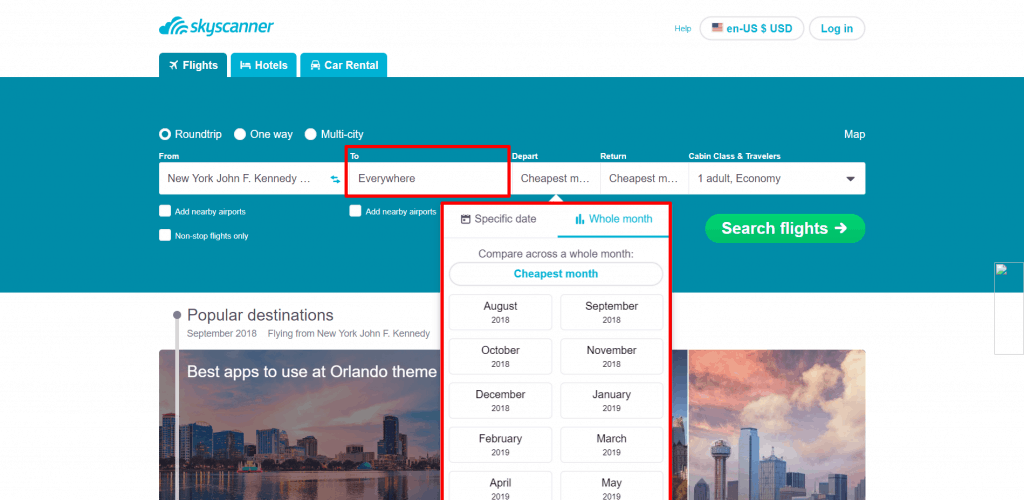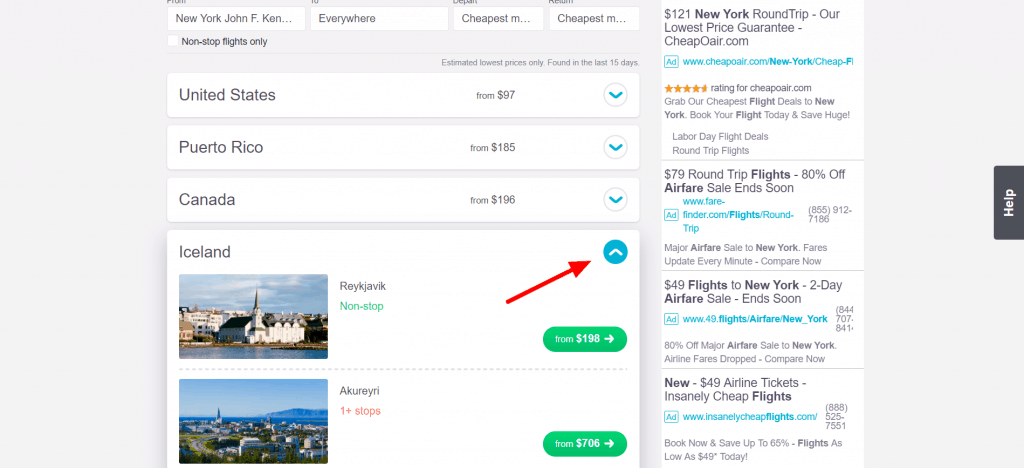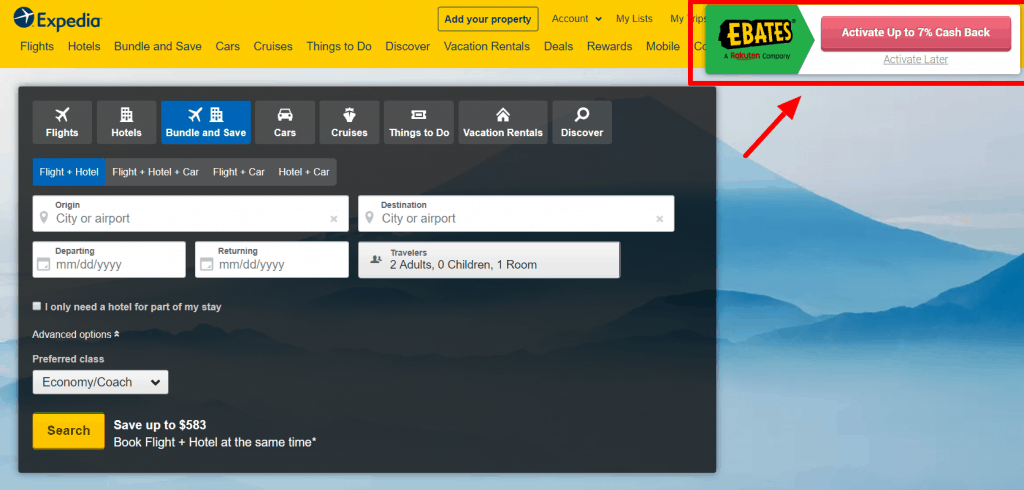Want to globetrot without emptying your bank account? It all starts with being smart about booking the flight. In my experience, one of the most expensive parts of travel is actually getting to your destination.
But there are a few tricks you can use to slash flight costs and start exploring the globe.
8 Ways to Find Cheap Flights
I’m always on the lookout for opportunities to see new parts of the world. These are a few strategies I use to keep it affordable.
1. Flight First, Other Details Later
If your first steps are booking hotels and planning activities, but you leave the actual flights until later, you’ll be stuck with whatever you get. Typically, the closer you get to your departure date, the more prices rise, so it’s not advisable to wait too long.
When I plan travel, my very first step is finding a flight deal. My favorite tool for this is Skyscanner, which literally lets you search “Everywhere” when you don’t have a destination in mind yet.
Once I see a good flight, I’ll do some quick research about the location, scope out accommodation options just to make sure there are some available on those dates, and then just go ahead and book before prices rise.
The other logistics, like actually booking the accommodation, come second — you just want to be sure you have the flight itself locked down first, since that will affect the rest of your plans.
Want to see just how powerful booking early can be? Here’s a sample search from JFK in New York to Oslo, Norway.
This is the price to book last-minute:
And this is the price to book about a year in advance:
Booking early is also the way to get the best places to stay. I know it can be mentally harder to book so far ahead when it still feels abstract — but for practicality’s sake, advance planning is usually the way to go.
If you’re not on board for the impatience of waiting 12 months to go on your trip, don’t worry: it doesn’t have to be that far ahead. Booking 70-90 days before departure seems to be a good sweet spot, according to this study.
2. Check Other Airports
You don’t have to limit yourself to the airport closest to your home. In some cases, it can pay off to travel the extra distance to get to a larger hub airport, even if you have to spend a bit more to get yourself there.
A lot of flight tools will make airport comparisons easy by allowing you to check a box that says something like “Add nearby airports.” Here’s how it looks on the flight search site Kayak:
This will give you results for a wider radius than just your home airport. From there, you can weigh the cost savings vs. extra time and hassle for you.
For instance, if you could save $200 by driving an extra hour, that’s like being paid $200 an hour. (And I don’t know about you, but my regular hourly rate isn’t quite there yet!)
But if you’d only save $40, the transportation and time costs might not be worth it.
3. Search With Flexible Timing and Destinations
Not sure where you want to go? That’s actually a benefit!
During the planning process, the more flexible you can be about when and where you want to travel, the better deals you’ll be able to find. Unless you’re forced to lock down your plans to a specific location on a specific date, leave it open!
But if you don’t know where you’re going, how can you possibly search for flights? There are a couple ways!
My favorite tool for this is Skyscanner. Simply plug in the city you want to leave from. In the “To” field, put “Everywhere.” In the depart- and return-date fields, you can choose specific months or even filter based on what is the cheapest time to go.
From there, Skyscanner looks through available flight data and breaks down results by country and cheapest available price.
If you’re interested in a specific country, you can click the arrow to view specific cities, then click through to see available dates and carriers.
This way, you spot a flight that’s cheap and the destination interests you, you can just go for it!
You might even surprise yourself and go somewhere you hadn’t even been considering, especially if you see a flash deal for it. Which brings me to a related point…
4. Monitor Flash Travel Deal Pages and Newsletters
Open to booking a little spontaneously? There are several sites that feature flash travel deals or “error fares” where prices briefly drop much lower than usual. These can expire within hours or within days, so time is of the essence.
Here are the two I mostly follow:
- TravelPirates.com (pictured): This site features deals originating from the U.S. and Canada to both domestic and international locations. You can follow TravelPirates on Facebook or Twitter for live updates so you don’t have to check the website all the time. You could be scrolling through your feed at lunch and have a flight booked by dinner! This is how I got a $200 roundtrip flight to Iceland.
- SecretFlying.com: This one tends to include a lot more international deals. On their site, you can plug in your departure country to find any travel deals originating from that location. They also have Facebook, Twitter, and Instagram pages.
There’s no signup required on either site, and no fees.
If you prefer email newsletters, here are two more options:
- Scott’s Cheap Flights: On the free version you’ll be sent one out of every three deals. Buying premium for $39/year means you’ll get all the deal alerts.
- Fly Almost Free: On the free version, you’ll be sent 10-15 deals per month. Upgrade to the paid version ($66/year) to be sent 30-50 per month.
Personally, I’m subscribed to the free versions of both newsletters. If you travel often, you might decide that upgrading to premium will pay for itself in savings.
5. Use Cash Back Portals and Credit Cards
A cash-back portal is an easy option you can easily use for extra flight savings.
I use Rakuten (Ebates) (pictured above), which has several flight-site partners, including big names like Expedia and CheapOair.
Just by clicking through Ebates to the flight website when you book, or using the in-browser button, you can earn extra cash, paid via check or PayPal. See more in my full Ebates review here.
There are no fees to use Ebates, and no personal info is required other than general stuff like name/email, so it’s a really simple way to maximize affordability once you’ve chosen a flight. Sign up for Ebates and get a $10 bonus to start!
Using credit cards can also help you save hundreds of dollars on flights, thanks to points and incentives–as long as you pay them off right away.
For instance, if you’re thinking about booking a $500 flight, you can save $150 just by booking it with a new Chase Freedom Unlimited card, thanks to their $150 sign-up bonus.
I won’t go into too much detail on credit cards here, because you can read more in my article on Using Credit Cards to Make Money and Travel for Free.
6. Watch Out for Hidden Costs
When you use a flight search site like Skyscanner or Kayak, the number you see is the base cost of the flight, before any fees. This means that some airlines seem cheaper up-front, but actually aren’t once you factor in hidden costs.
Notably, be sure to look up an airline’s baggage policies and fees before you choose a flight. For instance, some U.S.-based airlines charge for carry-on baggage, while others don’t.
Here’s an example: two “budget” carriers I often see on my results page are Frontier and Spirit, but on both of these airlines, you’ll pay $30-$60 each way to bring baggage.
So if you see a Delta flight for $150 roundtrip, and a Spirit flight for $100, the Delta flight might actually work out to be cheaper since they include a carry-on for free. Spirit’s baggage costs could make the final cost go up to $160+.
The same goes for seat selection: if you want to sit with a friend or partner on the plane, you can often expect to pay for the privilege. However, some airlines will let you choose seats for free when you check in for your flight.
7. Consider Basic Economy (But Weigh Your Options)
In the past year or so, more airlines have been introducing “basic economy” fares. This is a great option if you’re cool with roughing it a little on the flight.
Usually, a basic economy fare means no seat selection (in other words, expect to be stuck in the middle seat), no carry-on (so if you have more luggage than a small “personal item,” you’ll need to pay to check a bag), and no flight changes (so if you need to cancel or modify your flight, you’re out of luck).
If you can live with all that, basic economy can definitely be a money-saver.
I used Basic Economy for the first time earlier this year while flying down to hike in the Great Smoky Mountains. Every other flight I saw was in the $200 range.
Then I spotted the Basic Economy fare for $50. By the time I paid to check a bag, it was $75, but still…not a bad price for that view! And as luck would have it, I didn’t even get stuck next to a crying baby or a seatmate coughing up a lung from the bubonic plague.
However, as mentioned above, different airlines have different fees for things like luggage, so look these up to calculate the total cost before you book.
8. Remember: Off Season, Best Season
Demand affects pricing, so identify the times when most people will be going to your destination, and plan around them. Unless you’re taking a family trip with kids, this usually means traveling during the school year, when fewer people will have the ability to pick up and go.
I tend to avoid traveling much in the summer for this reason: expensive, crowded, and hot are not three of my favorite adjectives.
Now, that’s not to say you have to settle for taking all your trips when the weather is bad or everything is closed. If you aim for the “sweet spot” right before and after the high season at your destination, you’ll usually still get cheap prices and favorable conditions. In the U.S. and Europe, this might mean April-May or September-October.
Students are in school so competition for flights is thinner, but you’ll have mild weather and plenty of local activity. Once you’ve scored a cheap flight, make sure to prepare yourself for long-haul flight.
What’s the best flight deal you’ve ever gotten? Do you have tips to add?
Related: Cheapest European Cities to Visit
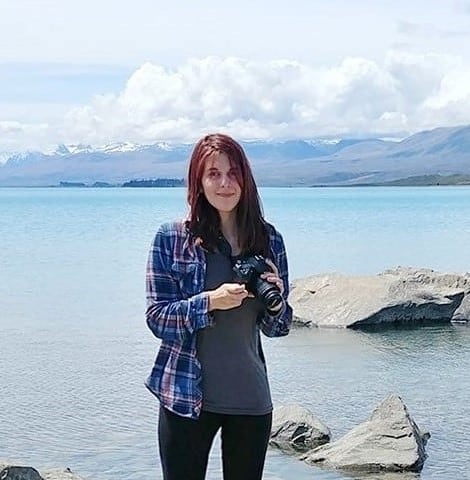
Kate is a writer and editor who runs her content and editorial businesses remotely while globetrotting as a digital nomad. So far, her laptop has accompanied her to New Zealand, Asia, and around the U.S. (mostly thanks to credit card points). Years of research and ghostwriting on personal finance led her to the FI community and co-founding DollarSanity. In addition to traveling and outdoor adventure, Kate is passionate about financial literacy, compound interest, and pristine grammar.

